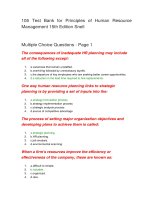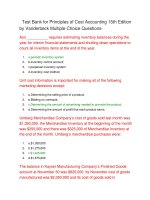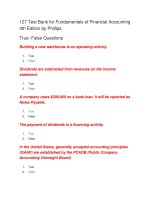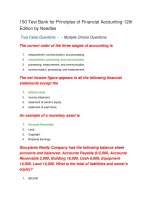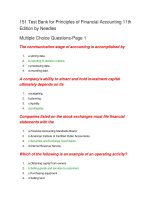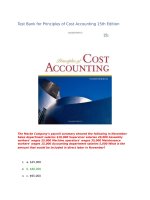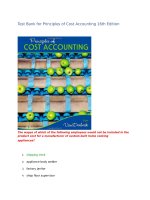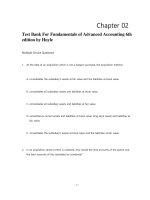Test bank for principles of human physiology 4th edition by stanfield
Bạn đang xem bản rút gọn của tài liệu. Xem và tải ngay bản đầy đủ của tài liệu tại đây (192.81 KB, 23 trang )
Link full download: />
Test bank for Principles of Human Physiology 4th Edition
by Stanfield
Chapter 1 Introduction to Physiology
1.1 Multiple Choice Questions
1) The smallest living units capable of carrying out their own basic life functions are called
________.
A) organs
B) organ systems
C) tissues
D) cells
E) organelles
Answer: D
Diff: 2
Page Ref: 3
2) ________ carry/carries oxygen to the cells of the body, while the synthesis of these cells is
regulated by the hormone ________.
A) Erythrocytes : bone marrow
B) Bone marrow : erythrocyte
C) Erythrocytes : erythropoietin
D) Erythropoietin : erythrocyte
E) Bone marrow : erythropoietin
Answer: C
Diff: 4
Page Ref: 2
3) Which of the following is NOT one of the major cell types found in the human body?
A) epithelial cells
B) muscle cells
C) endocrine cells
D) nervous cells
E) connective tissue cells
Answer: C
Diff: 3
Page Ref: 3
4) Which of the following is NOT a primary type of tissue?
A) muscle
B) skeletal
C) nerve
D) epithelial
1
Copyright © 2011 Pearson Education, Inc.
E) connective
Answer: B
Diff: 3
Page Ref: 3
2
Copyright © 2011 Pearson Education, Inc.
5) The tissue type that generates mechanical force and movement, and whose activity is
controlled both on a voluntary and involuntary level, is ________.
A) muscle tissue
B) epithelial tissue
C) connective tissue
D) nervous tissue
E) skeletal tissue
Answer: A
Diff: 4
Page Ref: 5
6) What tissue type functions in the transport of specific molecules from one body compartment
to another?
A) muscle tissue
B) epithelial tissue
C) connective tissue
D) nervous tissue
E) reticular tissue
Answer: B
Diff: 4
Page Ref: 5
7) What tissue type lines internal hollow organs and external surfaces of the body, providing a
barrier between the internal and external environment?
A) epithelial tissue
B) muscle tissue
C) nervous tissue
D) connective tissue
E) reticular tissue
Answer: A
Diff: 4
Page Ref: 5
8) Glands are derived from what type of tissue?
A) muscle
B) connective
C) epithelial
D) nerve
E) kleenex
Answer: C
Diff: 3
Page Ref: 5
9) What type of tissue lines exocrine glands?
A) connective
B) epithelial
C) exonuclear
D) nerve
E) muscle
Answer: B
3
Copyright © 2011 Pearson Education, Inc.
Diff: 4
Page Ref: 5
10) Endocrine glands are derived from what type of tissue?
A) muscle
B) nerve
C) epithelial
D) connective
E) reticular
Answer: C
Diff: 3
Page Ref: 5
11) What type of gland secretes products into ducts leading to the external environment?
A) endocrine glands
B) exocrine glands
C) both endocrine and exocrine
D) neither endocrine nor exocrine
Answer: B
Diff: 4
Page Ref: 5
12) Which tissue type includes cells contained in an extracellular matrix composed of collagen
and elastin?
A) muscle tissue
B) epithelial tissue
C) connective tissue
D) nervous tissue
E) endocrine tissue
Answer: C
Diff: 3
Page Ref: 5
13) Which of the following descriptions INCORRECTLY describes the tissue type?
A) Muscle tissue is specialized for contraction and generation of force.
B) Epithelial tissue forms glands.
C) Nervous tissue is specialized for transmission of electrical impulses.
D) Connective tissue is specialized for exchange between the internal and external environments.
E) Epithelial tissue lines the lumen of internal organs.
Answer: D
Diff: 4
Page Ref: 5
14) What is a general name for the non-cellular material that holds the widely scattered cells of
connective tissue together?
A) Basement membrane
B) Collagen
C) Intracellular matrix
D) Extracellular matrix
E) Elastin
Answer: D
4
Copyright © 2011 Pearson Education, Inc.
Diff: 4
Page Ref: 5
15) Which of the following is a protein found in the body that provides the tensile strength to
resist stretching?
A) Collagen
B) Elastin
C) Erythropoietin
D) Basement membrane
E) Vimentin
Answer: A
Diff: 4
Page Ref: 5
16) Which of the following is a tissue type that includes the cells found within blood and bones?
A) muscle tissue
B) epithelial tissue
C) connective tissue
D) nervous tissue
E) endocrine tissue
Answer: C
Diff: 4
Page Ref: 5
17) What are the structures that attach bone to muscle called?
A) ligaments
B) aponeuroses
C) extracellular matrix proteins
D) tendons
E) intracellular matrix proteins
Answer: D
Diff: 4
Page Ref: 5
18) Organs of the body are defined as ________.
A) a collection of cells that perform similar functions
B) two or more tissues combined to form a structure that allows each tissue to function
independently
C) a collection of cells that function independently of one another
D) a combination of two or more tissues that makes a structure which performs specific
functions
E) a collection of tissues that function independently of one another
Answer: D
Diff: 3
Page Ref: 5
5
Copyright © 2011 Pearson Education, Inc.
19) Which of the following accurately represents the order of complexity for the components of
the body, from least to most complex?
A) organ systems, cells, tissues, organs
B) tissues, cells, organs, organ systems
C) cells, tissues, organs, organ systems
D) cells, tissues, organ systems, organs
E) organ systems, organs, tissues, cells
Answer: C
Diff: 2
Page Ref: 5
20) Which of the following organ systems is primarily involved in the process of digestion?
A) immune system
B) endocrine system
C) gastrointestinal system
D) cardiovascular system
E) integumentary system
Answer: C
Diff: 2
Page Ref: 5
21) Which of the following is NOT a component of the gastrointestinal system?
A) salivary glands
B) stomach
C) gall bladder
D) liver
E) kidneys
Answer: E
Diff: 4
Page Ref: 5
22) Name the two organ systems that the kidneys belong to.
A) urinary and digestive systems
B) urinary and immune systems
C) endocrine and urinary systems
D) urinary and skeletal systems
E) endocrine and gastrointestinal systems
Answer: C
Diff: 5
Page Ref: 6
23) The uptake of nutrients across the epithelial cells of the gastrointestinal tract and into the
bloodstream is called ________.
A) filtration
B) excretion
C) secretion
D) absorption
E) reabsorption
Answer: D
Diff: 4
Page Ref: 7
6
Copyright © 2011 Pearson Education, Inc.
24) What organ system includes the pituitary gland, adrenal gland, and thyroid gland?
A) nervous
B) endocrine
C) cardiovascular
D) integumentary
E) immune
Answer: B
Diff: 3
Page Ref: 6
25) What organ system protects the body against pathogens and abnormal cells?
A) nervous
B) endocrine
C) respiratory
D) integumentary
E) immune
Answer: E
Diff: 3
Page Ref: 6
26) What organ system functions in communication between cells of the body?
A) nervous only
B) integumentary only
C) endocrine only
D) both nervous and endocrine
E) nervous, integumentary, and endocrine
Answer: D
Diff: 4
Page Ref: 6
27) What type of tissue separates the internal from the external environment?
A) connective
B) epithelial
C) plasma membrane
D) nerve
E) reticular
Answer: B
Diff: 3
Page Ref: 4
28) The lumen of which of the following systems is part of the INTERNAL environment?
A) gastrointestinal system
B) respiratory system
C) cardiovascular system
D) urinary system
E) gastrointestinal and urinary systems
Answer: C
Diff: 4
Page Ref: 6
7
Copyright © 2011 Pearson Education, Inc.
29) What separates the internal environment of the body from the external environment?
A) water
B) walls of blood vessels
C) membranes of blood cells
D) plasma membrane of all body cells
E) epithelium
Answer: E
Diff: 4
Page Ref: 6
30) Which of the following is NOT a part of the internal environment?
A) blood
B) brain
C) heart
D) airways to lungs
E) endocrine glands
Answer: D
Diff: 4
Page Ref: 7
31) The process whereby fluid from the bloodstream enters the tubules of the kidneys is called
________.
A) filtration
B) excretion
C) secretion
D) absorption
E) reabsorption
Answer: A
Diff: 5
Page Ref: 8
32) The process whereby fluid in the kidneys is transported from the tubules back into the
bloodstream is called ________.
A) filtration
B) excretion
C) secretion
D) absorption
E) reabsorption
Answer: E
Diff: 5
Page Ref: 8
33) Referring to a membrane as "selectively permeable" describes its ability to ________.
A) restrict the movement of particular molecules across a membrane
B) restrict only the movement of sodium across a membrane
C) provide a barrier that restricts the movement of all molecules across a membrane
D) provide a minimal barrier that allows almost any molecule to move across a membrane
E) restrict only the movement of potassium across the membrane
Answer: A
Diff: 6
Page Ref: 8
8
Copyright © 2011 Pearson Education, Inc.
34) Extracellular fluid is composed of ________.
A) interstitial fluid and plasma
B) plasma and intracellular fluid
C) interstitial fluid only
D) plasma only
E) intracellular fluid only
Answer: A
Diff: 4
Page Ref: 9
35) Total body water is composed of ________.
A) intracellular fluid only
B) extracellular fluid only
C) intracellular and interstitial fluid
D) intracellular and extracellular fluid
E) plasma and intracellular fluid
Answer: D
Diff: 4
Page Ref: 9
36) Where is most of our total body water?
A) in the lumen of the kidneys
B) in the lumen of the gastrointestinal tract
C) in blood
D) inside cells
E) surrounding the cells
Answer: D
Diff: 3
Page Ref: 9
37) Which of the following compartments contains most of the water found in the human body?
A) intracellular fluid
B) plasma
C) interstitial fluid
D) extracellular fluid
E) lumen of the intestinal tract
Answer: A
Diff: 3
Page Ref: 9
38) What are the two extracellular fluid compartments of the body?
A) intracellular fluid and interstitial fluid
B) intracellular fluid and plasma
C) intracellular fluid and blood
D) interstitial fluid and plasma
E) interstitial fluid and blood
Answer: D
Diff: 3
Page Ref: 9
9
Copyright © 2011 Pearson Education, Inc.
39) The portion of body water outside of cells that bathes most cells of the body is called
________.
A) intracellular fluid
B) intercellular fluid
C) interstitial fluid
D) plasma
E) extracellular fluid
Answer: C
Diff: 3
Page Ref: 9
40) The fluid compartment with a high sodium and protein concentration is called ________.
A) interstitial fluid
B) plasma
C) intracellular fluid
D) extracellular fluid
E) intracellular and extracellular fluids
Answer: B
Diff: 7
Page Ref: 9
41) Which of the following best describes intracellular fluid?
A) rich in sodium, potassium, and chloride
B) rich in sodium and chloride
C) rich in proteins and chloride
D) rich in proteins and potassium
E) rich in potassium and chloride
Answer: D
Diff: 4
Page Ref: 9
42) The fluid compartment with a high sodium concentration that contains only trace amounts of
protein is called ________.
A) interstitial fluid
B) plasma
C) intracellular fluid
D) extracellular fluid
E) intracellular and extracellular fluids
Answer: A
Diff: 5
Page Ref: 9
43) Homeostasis is a term which describes the process whereby the body ________.
A) affects the external environment
B) maintains a constant external environment
C) maintains a constant internal environment
D) maintains a variable internal environment
E) maintains a constant internal and external environment
Answer: C
Diff: 3
Page Ref: 9
10
Copyright © 2011 Pearson Education, Inc.
44) Which of the following statements about homeostasis is FALSE?
A) The extracellular fluid is maintained in a state compatible for life.
B) The primary mechanism to maintain homeostasis is negative feedback.
C) The organ systems work together to maintain homeostasis.
D) The intracellular fluid makes up the majority of the body fluids.
E) Intrinsic control mechanisms maintain the extracellular fluid in a constant state.
Answer: E
Diff: 4
Page Ref: 10
45) The maintenance of a stable internal environment compatible for life is called what?
A) physiology
B) anatomy
C) biochemistry
D) microbiology
E) homeostasis
Answer: E
Diff: 2
Page Ref: 9
46) What is the primary mechanism for maintaining homeostasis?
A) positive feedback
B) negative feedback
C) intrinsic control
D) extrinsic control
E) inherent control
Answer: B
Diff: 3
Page Ref: 9
47) Which of the following statements about homeostasis is FALSE?
A) The extracellular fluid is maintained in a state compatible for life.
B) The primary mechanism to maintain homeostasis is positive feedback.
C) The organ systems work together to maintain homeostasis.
D) Illness can result if homeostasis is disrupted.
E) Homeostasis is the maintenance of the internal environment.
Answer: B
Diff: 4
Page Ref: 9
48) Changes in the external environment alter the ________, which is detected by the ________,
and that information is sent to the integrator.
A) set point : regulated variable
B) regulated variable : set point
C) error signal : regulated variable
D) sensor : regulated variable
E) regulated variable : sensor
Answer: E
Diff: 4
Page Ref: 10
11
Copyright © 2011 Pearson Education, Inc.
12
Copyright © 2011 Pearson Education, Inc.
49) The ________ determines the extent of the error signal in a feedback loop, in order to initiate
the appropriate response.
A) sensor
B) integrator
C) effector
D) set point
E) regulated variable
Answer: B
Diff: 6
Page Ref: 12
50) The process of maintaining the internal environment in a state compatible for life is called
________, and it occurs primarily through ________.
A) intrinsic control : homeostasis
B) negative feedback : intrinsic control
C) homeostasis : negative feedback
D) intrinsic control : negative feedback
E) positive feedback : intrinsic control
Answer: C
Diff: 4
Page Ref: 10
51) Which of the following is an example of negative feedback?
A) If blood pressure increases above normal, baroreceptors in major arteries detect the change
and send signals to the brain. Certain areas of the brain then send signals to the nerves that
control the heart and blood vessels to make the heart beat slower and the blood vessels increase
in diameter, which in turn reduce the blood pressure.
B) During a blood clot, platelets release ADP, which stimulates platelet aggregation, causing
platelets to release more ADP.
C) During an infection, the body temperature set point is increased. The hypothalamus
communicates to skeletal muscles to shiver and to blood vessels to decrease blood flow to the
skin, causing a rise in body temperature.
D) At the time of birth, uterine contractions push the baby toward the cervix. Receptors in the
cervix detect the pressure caused by the baby and cause the release of a hormone called oxytocin.
This hormone stimulates stronger uterine contractions, which push more on the baby, causing an
increase in pressure and another increase in oxytocin. The cycle continues until the baby is
delivered from the mother.
E) Consumption of caffeine increases urine output, causing dehydration.
Answer: A
Diff: 5
Page Ref: 10
13
Copyright © 2011 Pearson Education, Inc.
52) Luteinizing hormone-mediated regulation of estrogen during ovulation in women is an
example of ________.
A) a negative feedback loop
B) a positive feedback loop
C) a quasi-negative feedback loop
D) a quasi-positive feedback loop
E) both a positive and negative feedback loop
Answer: B
Diff: 5
Page Ref: 12
53) The positive feedback loop involving luteinizing hormone and estrogen is terminated by
________.
A) nothing; the cycle cannot be terminated
B) ovulation, which decreases estrogen secretion
C) pregnancy
D) birth
E) ovulation, which directly inhibits luteinizing hormone secretion
Answer: B
Diff: 5
Page Ref: 12
54) Which of the following is a normal blood glucose level?
A) 100 mg/dL
B) 100 gm/mL
C) 50 mg/dL
D) 50 mmolar
E) 200 mmolar
Answer: A
Diff: 4
Page Ref: 15
55) What is the difference between diabetes mellitus and diabetes insipidus?
A) one is a deficit in insulin activity, the other a deficit in ADH activity
B) one is a lack of insulin secretion, the other a resistance to insulin
C) one is a lack of ADH secretion, the other a resistance to ADH
D) one causes increased fluid loss, the other causes increased thirst
E) one causes diarrhea the other causes diuresis
Answer: A
Diff: 6
Page Ref: 14
56) What cells secrete insulin?
A) I cells of the adrenal cortex
B) G cells of the adrenal cortex
C) alpha cells of the pancreas
D) beta cells of the pancreas
E) several cells located throughout the body
Answer: D
Diff: 5
Page Ref: 15
14
Copyright © 2011 Pearson Education, Inc.
57) Approximately what percentage of people living in the United States suffer from diabetes
mellitus?
A) 0.1%
B) 0.5%
C) 1%
D) 8%
E) 15%
Answer: D
Diff: 4
Page Ref: 13
58) Who would be more prone to develop diabetes mellitus type II?
A) thin, malnourished African American child
B) obese white adult
C) thin white adult
D) obese hispanic adult
E) obese hispanic child
Answer: D
Diff: 6
Page Ref: 13
59) What percentage of adults in the United States is obese?
A) 10%
B) 15%
C) 20%
D) 25%
E) 30%
Answer: E
Diff: 4
Page Ref: 13
60) Type I diabetes mellitus is also known as ________.
A) juvenile onset diabetes mellitus
B) adult onset diabetes mellitus
C) ketoacidosis
D) non-insulin dependent diabetes mellitus
E) diabetes insipidus
Answer: A
Diff: 4
Page Ref: 14
15
Copyright © 2011 Pearson Education, Inc.
1.2 True/False Questions
1) Physiologists use research tools from different fields that include biochemistry and cell
biology.
Answer: TRUE
Diff: 2
Page Ref: 2
2) Cardiac muscle is located in the heart.
Answer: TRUE
Diff: 2
Page Ref: 4
3) Connective tissue forms both endocrine and exocrine glands.
Answer: FALSE
Diff: 2
Page Ref: 4
4) Exocrine glands secrete hormones.
Answer: FALSE
Diff: 3
Page Ref: 4
5) The immune system protects the body from invading microorganisms.
Answer: TRUE
Diff: 3
Page Ref: 6
6) Most of the cells of the body are able to directly exchange materials with the external
environment.
Answer: FALSE
Diff: 4
Page Ref: 7
7) The internal and external environments are separated by the selectively permeable membranes
of epithelial cells.
Answer: TRUE
Diff: 3
Page Ref: 8
8) The most abundant substance in the body is carbon.
Answer: FALSE
Diff: 2
Page Ref: 9
9) Intracellular and extracellular fluid are of the same ion composition.
Answer: FALSE
Diff: 3
Page Ref: 9
10) The homeostatic mechanisms of the body are unlimited in their ability to respond to changes
in the external environment.
Answer: FALSE
Diff: 4
Page Ref: 9
16
Copyright © 2011 Pearson Education, Inc.
11) Blood glucose is a regulated variable.
Answer: TRUE
Diff: 2
Page Ref: 10
12) Effectors bring about a final response in a negative feedback loop.
Answer: TRUE
Diff: 3
Page Ref: 10
13) Positive feedback loops are impossible to stop once they have begun.
Answer: FALSE
Diff: 4
Page Ref: 12
14) All forms of diabetes involve a decrease in plasma levels of insulin.
Answer: FALSE
Diff: 4
Page Ref: 15
15) Diabetes mellitus requires insulin injections for maintenance.
Answer: FALSE
Diff: 4
Page Ref: 15
16) Once a person develops gestational diabetes, she will have diabetes for life?
Answer: FALSE
Diff: 6
Page Ref: 14
17) People with a body mass index (BMI) less than 25 are most prone to develop type 2 diabetes
mellitus.
Answer: FALSE
Diff: 5
Page Ref: 13
18) Cases of diabetes mellitus are increasing throughout the world, not just in the United States.
Answer: TRUE
Diff: 6
Page Ref: 13
19) Obesity predisposes a person to develop type 1 diabetes mellitus.
Answer: FALSE
Diff: 4
Page Ref: 13
20) Diabetes mellitus causes hyperglycemia.
Answer: TRUE
Diff: 3
Page Ref: 15
17
Copyright © 2011 Pearson Education, Inc.
1.3 Matching Questions
Match the following functions to the correct tissue type.
A) connective tissue
B) muscle tissue
C) nervous tissue
D) epithelial tissue
1) Specialized for exchange of material.
Diff: 2
Page Ref: 4
2) Conducts signals via electrical impulses.
Diff: 2
Page Ref: 3
3) Provides structural support.
Diff: 2
Page Ref: 4
4) Contracts to generate a force.
Diff: 2
Page Ref: 3
Answers: 1) D 2) C 3) A 4) B
Match the following descriptions with the correct function.
A) excretion
B) absorption
C) filtration
5) Elimination from the body.
Diff: 3
Page Ref: 8
6) Movement from the lumen of the gastrointestinal tract to blood.
Diff: 3
Page Ref: 7
7) Movement from blood into the kidney tubules.
Diff: 3
Page Ref: 8
Answers: 5) A 6) B 7) C
18
Copyright © 2011 Pearson Education, Inc.
Match the organ to the organ system with which it belongs.
A) endocrine system
B) nervous system
C) cardiovascular system
D) respiratory system
E) gastrointestinal system
8) Adrenal gland
Diff: 5
Page Ref: 6
9) Esophagus
Diff: 4
Page Ref: 6
10) Blood vessels
Diff: 3
Page Ref: 6
11) Bronchi
Diff: 4
Page Ref: 6
12) Brain
Diff: 2
Page Ref: 6
Answers: 8) A 9) E 10) C 11) D 12) B
1.4 Essay Questions
1) Describe the four general groups of cells (tissues) that are found in the body, outlining the
important characteristics of each group.
Answer: Nervous tissue - Neurons are specialized for the transmission of information in the
form of electrical signals. They typically possess a number of branches that function to receive or
transmit those electrical signals. Some are even capable of detecting sensory information.
Muscle tissue - Muscle cells are involved in force development and movement. They tend to be
elongated in shape and can be under either voluntary or involuntary control.
Epithelial tissue - Epithelial cells are arranged as a sheet-like layer of cells connected to a thin,
non-cellular basement membrane. These cells are found in many shapes, sizes, and layer
thicknesses. They are closely associated with their neighbors, providing a barrier separating body
fluids from the external environment. Certain epithelial cells are specialized to transport specific
molecules from one compartment to another.
Connective tissue - This tissue encompasses many cell types including blood cells, bone cells,
and many others. In a narrow sense, these cells provide physical support for other structures like
tendons and ligaments. In a broader sense, the term connective tissue encompasses fluids like
blood and lymph that "connect" parts of the body by providing an avenue for communication.
Diff: 3
Page Ref: 3
19
Copyright © 2011 Pearson Education, Inc.
2) Describe the essential role of water in the body and how it is compartmentalized throughout
the body.
Answer: Water is the most abundant molecule in the human body. It acts as a solvent for a
variety of solutes within the body. There are three compartments that comprise total body water
(TBW). Extracellular fluid (1/3 of TBW), the fluid outside of cells, is composed of two
compartments: 1) the fluid component of blood (plasma), which is composed mostly of sodium
and protein, and 2) the fluid that bathes cells (interstitial), which is composed primarily of
sodium with little protein present. The other component of TBW is intracellular fluid (2/3 of
TBW). This fluid is present inside cells (cytoplasm). Intracellular fluid is relatively high in
protein and potassium, and is separated from extracellular fluid by a cell membrane that is
selectively permeable, allowing only specific ions through.
Diff: 4
Page Ref: 8
3) Describe the role of insulin in negative feedback control of blood glucose levels.
Answer: Increases in blood glucose levels stimulate insulin secretion from beta cells of the
pancreas. Insulin acts on cells throughout the body increasing their uptake of glucose, thereby
removing glucose from the blood. This causes blood glucose levels to return toward normal.
Diff: 5
Page Ref: 15
4) Compare the different forms of diabetes.
Answer: There are several types of diabetes, including diabetes mellitus type 1, diabetes mellitus
type 2, diabetes insipidus, and gestational diabetes. Diabetes mellitus types 1 and 2 are
associated with insufficient actions of insulin causing hyperglycemia and a number of other
symptoms. Diabetes mellitus type 1 is caused by decreased secretion of insulin. Without
sufficient insulin, cells do not uptake glucose to meet their metabolic needs. Liver and muscle
cells do not uptake insulin to store energy for later needs. Thus hyperglycemia and fatigue are
common symptoms. In diabetes mellitus type 2, beta cells of the pancreas secrete insulin, but
effector cells do not respond to the insulin. Thus symptoms are similar to that of diabetes
mellitus type 1. Diabetes insipidus is a disease affecting the release of antidiuretic hormone
(ADH). ADH promotes water reabsorption from the kidneys, and in its absence (or a decrease in
tissue responsiveness to it), excessive water is lost in the urine causing dehydration. Gestational
diabetes develops in some pregnant women. It is similar to type 2 diabetes mellitus, with
hormones of pregnancy thought to induce the insulin resistance. Gestational diabetes often
reverses following delivery of the baby.
Diff: 5
Page Ref: 14
20
Copyright © 2011 Pearson Education, Inc.
1.5 Short Answer Questions
1) The smallest living units, capable of carrying out its own basic life processes are ________.
Answer: cells
Diff: 2
Page Ref: 2
2) Cells that carry oxygen in the bloodstream are called ________.
Answer: erythrocytes
Diff: 5
Page Ref: 2
3) Name the types of tissue described below.
This tissue is specialized for transport and exchange of material.
This tissue is a major component of bone, ligaments, and blood.
This tissue is specialized for generating electrical signals.
This tissue is specialized to contract.
Answer: epithelial, connective, nervous, muscle
Diff: 4
Page Ref: 3
4) Name the two types of glands and describe their secretions.
Answer: Exocrine glands secrete their product into ducts that lead to an epithelial surface.
Endocrine glands secrete their product (hormones) into the bloodstream where the hormones
travel throughout the body.
Diff: 4
Page Ref: 4
5) The specific structures that attach bone to bone are called ________.
Answer: ligaments
Diff: 5
Page Ref: 5
6) The layer of epithelial cells that coats the inside (lumen) of blood vessels is called the
________.
Answer: endothelium
Diff: 5
Page Ref: 4
7) The ________ is the interior compartment of a hollow organ or vessel.
Answer: lumen
Diff: 4
Page Ref: 4
8) What organ system(s) provides communication between the cells of the body?
Answer: nervous and endocrine
Diff: 5
Page Ref: 6
9) The process whereby enzymes are moved into the gastrointestinal tract to digest nutrients is
called ________.
Answer: secretion
Diff: 5
Page Ref: 7
21
Copyright © 2011 Pearson Education, Inc.
10) The process whereby fluid and ions that have not been removed by the kidneys exit the body
as urine is referred to as ________.
Answer: excretion
Diff: 4
Page Ref: 8
11) The fluid (non-cellular) portion of blood is called ________.
Answer: plasma
Diff: 4
Page Ref: 9
12) The fluid compartment with a high protein and potassium concentration is called ________.
Answer: intracellular fluid
Diff: 4
Page Ref: 9
13) Most of the water in the body is found (inside cells / in blood / bathing cells).
Answer: inside cells
Diff: 4
Page Ref: 9
14) Define homeostasis.
Answer: Homeostasis is the process whereby the body maintains the internal environment in a
state compatible for life.
Diff: 4
Page Ref: 9
15) Insulin is a hormone that regulates blood glucose levels. It is released when glucose levels
increase above normal. Based on the concept of negative feedback, insulin (increases /
decreases) blood glucose levels.
Answer: decreases
Diff: 5
Page Ref: 10
16) List the essential components of a feedback loop and describe their function.
Answer: Sensor - detects the regulated variable
Set point - value to which the regulated variable is compared by the integrator
Integrator - determines the extent of the error signal in order to provide appropriate effector
response
Effector - that which can alter the regulated variable
Diff: 5
Page Ref: 10
17) What cells secrete insulin and where are they located?
Answer: beta cells located in the islets of Langerhans in the pancreas
Diff: 6
Page Ref: 15
18) Insulin-dependent diabetes mellitus is also called ________.
Answer: type 1 diabetes mellitus or juvenile-onset diabetes mellitus
Diff: 4
Page Ref: 14
19) Body mass index is a measure of weight in kilograms relative to ________.
22
Copyright © 2011 Pearson Education, Inc.
Answer: height in meters (squared)
Diff: 4
Page Ref: 13
20) What percentage of people in the United States have diabetes mellitus?
Answer: 8
Diff: 5
Page Ref: 13
23
Copyright © 2011 Pearson Education, Inc.
